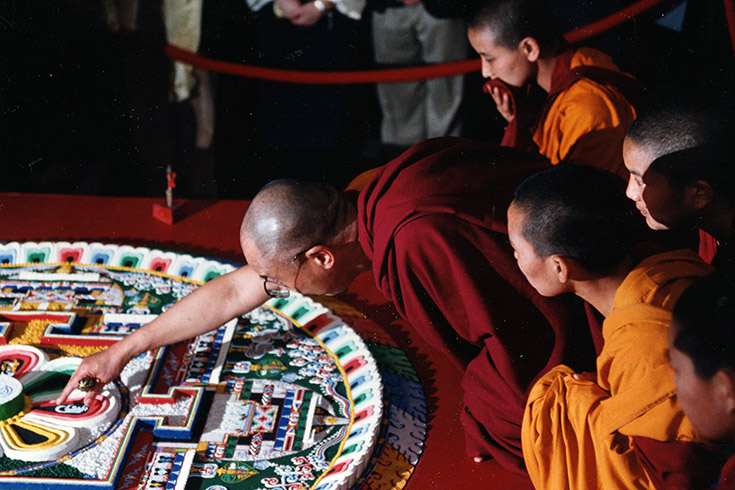Dalai Lama Visit
 The Dalai Lama with the sand mandala created by the Students for a Free Tibet at Brandeis
The Dalai Lama with the sand mandala created by the Students for a Free Tibet at Brandeis
In May 1998, His Holiness the 14th Dalai Lama visited Brandeis University, in part to commemorate the 50th anniversary of the institution. The Tibetan buddhist leader spoke of his exile from China and the importance of interfaith efforts towards peace.
In 1959, the Dalai Lama, along with 80,000 Tibetan refugees, fled their homes when China took control of Tibet. Using peaceful, non-violent tactics, the Dalai Lama helped advocate for his people’s human rights. He worked with the Tibetan Government operating in exile to help build Tibetan economic security and to establish an education system for Tibetan children to learn their own culture and language,all while living in fearful exile. Based on his own Buddhist ideals, His Holiness created a constitution for the nation of Tibet in 1963, leading to his proposal of a Peace Plan in 1987 to the Congressional Human Rights Caucus. He dreamed of establishing Tibet as a peaceful, nonviolent land. In 1989, the Dalai Lama was awarded the Nobel Peace Prize and the Raoul Wallenberg Congressional Human Rights Award. The recipient of many honorary degrees from several different universities, His Holiness continued to unconditionally stand for human rights.
In response to the events in Tibet, the Brandeis club Students for a Free Tibet held several events including a Tibetan-Jewish liberation seder, constructing a sand mandala, and a lecture panel on Non-Violence in World Religions, specifically Buddhism, Christianity, Hinduism, Islam, and Judaism. These programs, with assistance from the Tibetan Association of Boston, helped eductate the Brandeis community on the Tibetan-Chinese conflict, the history and culture of Tibet, and the tenants of Buddhism. These events culminated in the visit of the Dalai Lama, organized by the Program in Sustainable International Development at the Heller Graduate School.
His Holiness addressed 8,500 students, faculty, and community members during his visit to Brandeis. Much of his speech detailed his efforts towards Tibetan-Chinese reconciliation on all systemic levels, from schoolchildren to politicians to institutions. The Dalai Lama also spoke of his experience as an advocate for nonviolence, human rights, equity, compassion, and social justice. He continually cited his practice of mindfulness as the source of his resilience despite his traumatic experiences. He stated, “During such difficulties and turbulence in life…the most-trusted protector and helper is peace of mind…If you utilize compassion, it will bring you tranquility and strength.”
In his remarks, His Holiness also touched upon the similarities between the Jewish and Tibetan struggles for self-determination in the face of religious persecution. He spoke of the importance of interfaith solidarity in times of struggle. During the Dalai Lama’s visit, he took part in several interfaith activities, including a Jewish shabbat dinner with then-president Jehuda Reinharz, meeting with then-chaplain Rabbi Albert Axelrad, visiting with Tibetan nuns of Boston, and speaking with Peace, Conflict, and Coexistence studies Department Chair, Professor Gordon Fellman. Together, His Holiness and local religious figures celebrated the beauty of religious pluralism and the possibility of peace it brings. The path towards religious pluralism is still traveled today at Brandeis, as students balance their faith with their education and interact with a diverse group of peers of all faiths and backgrounds.